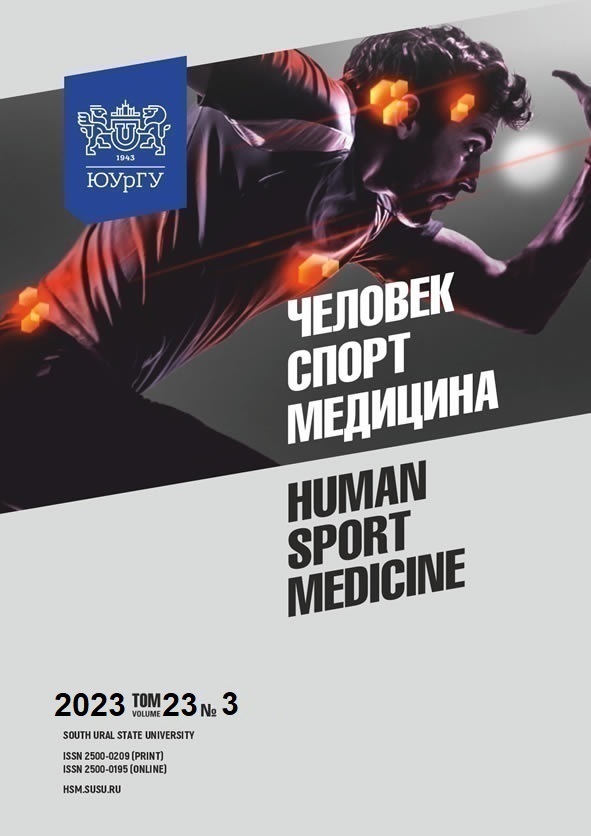РАЗВИТИЕ ДВИГАТЕЛЬНОЙ АКТИВНОСТИ ДЕТЕЙ СТАРШЕГО ДОШКОЛЬНОГО ВОЗРАСТА С ТЯЖЕЛЫМИ НАРУШЕНИЯМИ РЕЧИ
Аннотация
Цель: изучение показателей развития двигательной активности старших дошкольников с тяжелыми нарушениями речи. Материалы и методы. В исследовании приняли участие 60 детей старшего дошкольного возраста с тяжелыми нарушениями речи. Положенные в основу эмпирической части исследования материалы методики М.А. Руновой, модифицированные с учетом условий эксперимента и специфики дефекта, позволяют впоследствии дать всестороннюю оценку ключевых показателей двигательной активности: полноты и точности выполнения движений, их продолжительности и интенсивности. Результаты. В ходе исследования были выделены три группы детей с тяжелыми нарушениями речи со следующими уровнями двигательной активности: выше среднего (обнаружилось близкое к норме состояние моторной сферы в разных видах деятельности); средний (затруднения и несогласованность при удержании равновесия, ходьбе, поворотах; скованность, зажатость, неточность движений, синкинезии и др.); низкий (вариации тонуса мышц, легкие парезы, недостаточность воспроизведения точно дозированных действий). Для развития двигательной активности в самостоятельной деятельности у детей старшего дошкольного возраста с тяжелыми нарушениями речи был реализован ряд мероприятий: за счет специально сконструированной физкультурно-игровой зоны, учитывающей уровень и особенности двигательной деятельности дошкольников с тяжелыми нарушениями речи, расширен физкультурный уголок, способствующий проявлению двигательного творчества детей; осуществлена подготовка педагогов к использованию средств физической культуры с целью совершенствования двигательной активности в свободной деятельности у детей старшего дошкольного возраста с тяжелыми нарушениями речи. Заключение. Проведенное контрольное исследование подтвердило успешность реализации мероприятий и обнаружило позитивные сдвиги в отношении двигательной активности у старших дошкольников с тяжелыми нарушениями речи. Обогатилось содержание самостоятельной двигательной деятельности испытуемых, появился осознанный интерес к играм и упражнениям спортивно-творческой направленности (бадминтон, баскетбол, теннис).
Литература
2. Конвенция о правах ребенка: Конвенция ООН. – М.: ИНФРА-М, 2003. – 24 с.
3. Наумова, Е.В. Влияние двигательной активности на физическую подготовленность обучающихся с нарушением интеллекта / Е.В. Наумова, Т.В. Фендель // Теория и практика физ. культуры. – 2020. – № 3. – С. 72–74.
4. Послание Президента РФ Федеральному Собранию, 1.03.2018. – http://www.kremlin.ru/events/president/news/56957
5. Рунова, М.А. Движение день за днем: комплексы физических упражнений и игр для детей 5–7 лет (с использованием вариативной физкультурно-игровой среды) / М.А. Рунова. – М.: Линка-Пресс, 2007. – 93 с.
6. Assessing social cognitive functions in elementary school children: or problems of motor activity disorders / V.K. Eliseev, I.M. Eliseeva, M.V. Korobova, Yu.V. Romanova // Amazonia Investiga. – 2021. – Vol. 10, No. 37. – P. 125–134. DOI: 10.34069/AI/2021.37.01.13
7. Characteristics of the psychomotor system in preschool children with mental disabilities / V. Pasichnyk, M. Pityn, V. Melnyk et al. // Journal of Physical Education and Sport. – 2018. – Vol. 18. – P. 349–355. DOI: 10.7752/jpes.2018.s147
8. Daily assessment of physical activity in 6–11-year-old children / V.L. Kondakov, L.N. Voloshina, E.N. Kopeikina, L. Kadutskaya // Journal of Physical Education and Sport. – 2020. – Vol. 20, No. 4. – P. 1673–1680. DOI: 10.7752/jpes.2020.04227
9. Hunt, J.H. Empowering students with specific learning disabilities: Jim's concept of unit fraction / J.H. Hunt, J. Silva, R. Lambert // The Journal of Mathematical Behavior. – 2019. – Vol. 56. – P. 100738. DOI: 10.1016/j.jmathb.2019.100738
10. Level-balanced psychomotor support program for preschool children with intellectual disabilities / V. Hladush, A. Symko, O. Havrilov, V. Silonova // Life Span and Disability. – 2021. – Vol. 24, No. 1. – P. 113–131.
References
1. Voloshina L.N., Isayenko Y.M. [Pedagogical Observation of the Motor Activity of Preschool Children]. Doshkol′noye vospitaniye [Preschool Education], 2007, no. 6, pp. 90–92. (in Russ.)2. Convention on the Rights of the Child: United Nations Convention. Moscow, INFRA-M Publ., 2003. 24 р. (in Russ.)
3. Naumova E.V., Fendel T.V. [Effects of Motor Activity on Physical Fitness of Students with Intellectual Retardations]. Teoriya i praktika fizicheskoy kul′tury [Theory and Practice of Physical Culture], 2020, no. 3, pp. 72–74. (in Russ.)
4. Message of the President of the Russian Federation to the Federal Assembly [Electronic Re-source]. Available at: http://www.kremlin.ru/events/president/news/56957 (accessed 1.03.2018)
5. Runova M.A. Dvizheniye den’ za dnem: kompleksy fizicheskikh uprazhneniy i igr dlya detey 5–7 let (s ispol’zovaniyem variativnoy fizkul’turno-igrovoy sredy) [Movement Day after Day. Complexes of Physical Exercises and Games for Children Aged 5–7 Years (Using a Variable Physical Culture and Game Environment)]. Moscow, Linka Publ., 2007. 93 p.
6. Eliseev V.K., Eliseeva I.M., Korobova M.V., Romanova Yu.V. Assessing Social Cognitive Functions in Elementary School Children: or Problems of Motor Activity Disorders. Amazonia Investiga, 2021, vol. 10, no. 37, pp. 125–134. DOI: 10.34069/AI/2021.37.01.13
7. Kondakov V.L., Voloshina L.N., Kopeikina E.N., Kadutskaya L. Daily Assessment of Physical Activity in 6–11-Year-Old Children. Journal of Physical Education and Sport, 2020, vol. 20, no. 4, pp. 1673–1680. DOI: 10.7752/jpes.2020.04227
8. Pasichnyk V., Pityn M., Melnyk V. et al. Characteristics of the Psychomotor System in Preschool Children with Mental Disabilities. Journal of Physical Education and Sport, 2018, vol. 18, pp. 349–355. DOI: 10.7752/jpes.2018.s147
9. Hunt J.H., Silva J., Lambert R. Empowering Students with Specific Learning Disabilities: Jim's Concept of Unit Fraction. The Journal of Mathematical Behavior, 2019, vol. 56, p. 100738. DOI: 10.1016/j.jmathb.2019.100738
10. Hladush V., Symko A., Havrilov O., Silonova V. Level-Balanced Psychomotor Support Program for Preschool Children with Intellectual Disabilities. Life Span and Disability, 2021, vol. 24, no. 1, pp. 113–131.
Copyright (c) 2023 Человек. Спорт. Медицина

Это произведение доступно по лицензии Creative Commons «Attribution-NonCommercial-NoDerivatives» («Атрибуция — Некоммерческое использование — Без производных произведений») 4.0 Всемирная.















